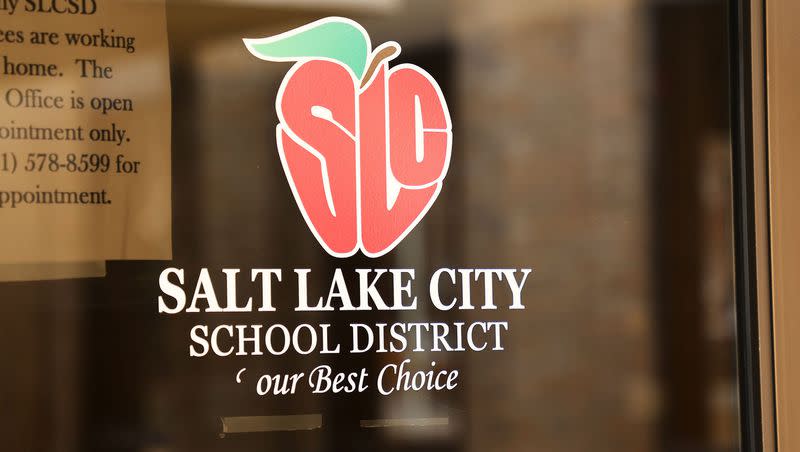Salt Lake City School District puts 4 elementary schools on potential closure list

The Salt Lake City School District on Monday night presented its recommendation to the district's board of education to close Riley Elementary, M. Lynn Bennion Elementary, Hawthorne Elementary and Mary W. Jackson Elementary.
The process of looking into the potential closures started in July 2022 with the district launching a population and boundary study in the face of a significantly declining elementary student population.
"In the last decade, we've lost about 30% of our elementary population and this year alone, where we have space to educate 15,000 elementary students, we have just over 9,300 kids in our district," said Yándary Chatwin, communications director for the district. "It's clear that we're operating more schools than we need to adequately serve our students and it's time for looking at some changes in our district."
All 27 elementary schools in the district were included in the population and boundary study, with seven schools — Emerson Elementary, Hawthorne Elementary, M. Lynn Bennion Elementary, Mary W. Jackson Elementary, Newman Elementary, Riley Elementary and Wasatch Elementary — presented to the board for further consideration for closure in July.
Of those seven schools, the district recommended closing Riley Elementary, M. Lynn Bennion Elementary, Hawthorne Elementary and Mary W. Jackson Elementary.
Chatwin said that the district concluded that it couldn't close all seven schools without creating too many logistical challenges, but it had to close schools more than fewer.
District Superintendent Elizabeth Grant said she wanted to recognize the gravity of closing schools and acknowledged that it's a difficult process for everyone.
"We all feel the significance of these choices. I want you to know we have been careful and measured in our decision-making," Grant said. "I am certain that it is in the best interest of our students and this district to consolidate schools and create vibrant learning communities in all of our schools."
Once the initial seven schools were narrowed down, the district studied schools near each other as pairs, recommending one from each pair for closure. Here's a glimpse of what went into the decision of which schools were recommended for closure.
Newman and Mary W. Jackson
Only 246 students live within the boundary of Newman Elementary and that number isn't expected to increase in the coming years. Newman Elementary is also home to a collaborative pre-kindergarten program that serves special education students alongside general education students, which the district says would be difficult to relocate.
Newman Elementary also has an estimated 38 years of building life, compared to only 18 years for Mary W. Jackson Elementary. While Mary W. Jackson has a robust dual-language immersion program (226 of 337 students take part in it), the district said that the program would be easier to relocate.
"Newman has smaller overall enrollment but its neighborhood program serves more students than Mary W. Jackson's neighborhood program and the (dual-language immersion) program can be located at a different school," Grant said. "With these and other factors, the district determined that Mary W. Jackson be recommended for closure."
M. Lynn Bennion and Wasatch
M. Lynn Bennion Elementary is home to only 156 students this year, with 48% of resident students choosing to attend another school. It's also located one block from two major thoroughfares (400 South and 700 East) and only has 26 classrooms — less than the district's target of 28.
Wasatch Elementary, however, has fewer years of useful building life when compared to M. Lynn Bennion (13 to 17) and poses "significant" accessibility concerns for stakeholders with certain disabilities or limitations.
With useful building life not being a factor due to the narrow margin, the district said that Bennion's small number of classrooms, proximity to two major thoroughfares and significant challenges in actual enrollment — in declining residential student population and in high percentage of resident students transferring to other schools — led to the decision to recommend M. Lynn Bennion Elementary for closure.
Emerson and Hawthorne
Had Emerson and Hawthorn Elementary not been located next to each other, the district said both schools had factors warranting their closure.
Emerson Elementary avoided the chopping block due primarily to its status as a district hub school serving students with disabilities and relocating the program would cause significant disruption.
Riley Elementary
Riley Elementary is currently home to 193 students and last year, 41% of residential students chose to attend a different school.
However, the study showed there are two, newer elementary schools within 1.5 miles of Riley Elementary that could welcome the influx of students caused by Riley Elementary's closure. Furthermore, Riley Elementary was the only school on the study list in its part of the city, making the closure recommendation apparent.
Other recommendations, moving forward
Grant also outlined other recommendations for schools in the district, with one being to avoid closing schools that are close together. Grant said closing schools close together would again require boundary changes and could require students to cross major roads to get to school.
Expanding access to "special district programs" was also recommended. These programs include the magnet Extended Learning Programs, dual-language programs and special education hubs. Grant said only one such program should be located at any given elementary school, but the district committed to bus students to their programs if they live more than 1.5 miles from their assigned school.
Additionally, Grant said that if a school closes, all faculty and staff at the closed school will be offered equivalent employment opportunities elsewhere within the district.
"Every employee brings value to the district and I want to acknowledge these contributions," Grant said.
The district has scheduled a public hearing on Dec. 5 at West High School at 6:30 p.m. for community members to provide input regarding the recommended closures. Chatwin said that a final decision on the closures won't be made until the board's Jan. 9 meeting, at the earliest.
An in-depth analysis and rationale of the district's recommendation, including potential boundary adjustments, can be found here.

